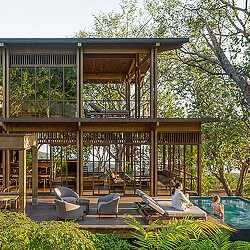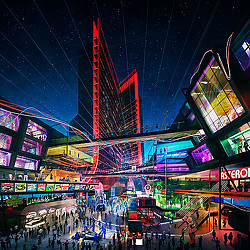Using Narrative Design and Local Context to Create Authentic and Memorable Hospitality Experiences
Our global leaders for Hospitality and Entertainment & Experience Design discuss the intersection of these two industries and their process for creating memorable destinations.

When designing for the travel and hospitality industries, the goal is often to create spaces that remove guests and travelers from their day-to-day lives. Similarly, immersive experiences have become a mainstay of culture, as people everywhere seek out shared, participatory moments that connect and inspire them.
We sat down with Tom Ito, global leader for Gensler’s Hospitality practice, and Ann Morrow Johnson, leader for Gensler’s Entertainment and Experience Design practice, to explore the intersection of these two industries and learn more about designing memorable experiences that offer more than just a place to stay or a photo to take home.
Gensler has defined the five attributes that contribute to an immersive experience. While some of these have clear applications to hospitality, what are some of the unexpected ways that these qualities transform a hospitality environment into an immersive experience? What does a narrative-based approach to hospitality design entail?
Ann Morrow Johnson: We focus our process by viewing design as a story we get to tell future guests. Every stone, wall, texture, and detail is an opportunity reinforce the narrative of a place so that it can really seep into you. This is especially true in vacation or resort destinations, where the goal is to soak in the moment and take in the place you have decided to go to recharge or be reinvigorated.
Tom Ito: We always try to wrap our designs in a narrative or story. People want to have meaningful experiences, to learn something new, and they want to go to places that have significance to local people, history, culture and heritage, and the physical environment. The Nekajui Ritz Carlton Reserve in Costa Rica is a great example of that: the whole development was built on learning about the culture and representing it in an eco-friendly way. Sustainability enhances that sense of purpose and informs why people might choose to stay at one hotel over another. Often immersive experiences at hotels involve sustainability or eco-tourism, where guests can plant trees or learn about native endangered species. Luxury is being redefined right now; it’s no longer what can I have and instead is what can I do that others can’t? That hyper-personalization creates more opportunities for immersion and unforgettable travel stories.

What are some of the ways we leverage narrative-driven design, experiences, or programming to reinforce the local context of a hotel?
AMJ: Using multiple senses to tell a specific story is an especially unique opportunity in the hospitality space. This is most obvious when transporting you to an other-worldly, fantastical place: rooms, events, and dining experiences that invite you to believe you’ve entered anything from a submarine to a fairy glen are on the rise and done with increasingly sophisticated attention to detail. It is perhaps most interesting when allowing you the opportunity to focus and be present — to be totally immersed in somewhere new. When we design with an eye towards using every sense to tell the story of a place, we can build memorable moments and spaces to meet the increasing desire for hyper-localized authentic travel.
I was in a lush Italian hotel bar recently that served a negroni with trace amounts of Roman clay in it. Did it catch me off guard? Yes. Did it immediately make me think about the literal layers of history beneath my feet and spark a lively debate about whether ancient drinks out of clay urns were maybe always a little bit silty tasting? Totally.
TI: Local craft is important, particularly in exotic places. We want to bring local craftsmanship, artisans, and sculptors into the design so that you create an experience that is unique and evocative of the local context. For Hotel Chaco in New Mexico, we worked with local Indigenous artists to create an environment that wasn’t a replication of older Southwest architecture but was a new vernacular that embraced and actually embedded the local culture in it. We oriented the buildings to align with the trajectory of the sun and created something truly immersive.
We strive to make spaces that engage the local community. In certain areas of a city, hotels become a hub not only for visiting guests but also for locals who come to work, eat, socialize, and host events. Lobbies are a great place for social interaction, and even in the lobby, you can separate those into different zones, and you can be flexible with that space during different times of the day. We're finding that to be a big driver not only to activate the space to create human interaction, but also it helps with the bottom line because operators are not just relying on guest stays for revenue.
How do you balance story-driven or thematic design with a sense of timelessness?
AMJ: A well-told story is timeless. Something that feels deep, layered, textured. Less about plot and more about reinforcing a feeling.
TI: It’s really about prioritizing the most meaningful, significant features of the storyline or the place. As designers, we know when to dial up and down for immersion.
For many people, travel is a transformative experience: experiencing new cultures and the wonder of nature, getting out of your comfort zone, unplugging and being able to just relax. How do you think about supporting and augmenting that sense of transformation when you approach a project?
AMJ: We are seeing a growing focus on immersive wellness. For this, we try to design in every opportunity to engage, relax, and transport oneself into a more holistic place. Music relaxes, connections with nature soothe, colors, sights, sounds, tastes, even how people interact with you, all have meaningful effects on how you respond physiologically to a place and moment. On the one hand, we are increasingly seeing distractions such as TVs excluded from places that are designed to help you unplug. Then, we design focal points that help you feel more present on the moment. For example, an arrival sequence that has you cross a threshold, experience a moment of compression, and then expansion that looks out onto a gorgeous vista might help you exhale and be present. I know I’m more likely to try something like a soundbath if held somewhere awe-inspiring, like a platform nestled into a tree canopy. It’s about designing experiences that make it easier to lose the noise and entice you to focus on the good.
TI: People are seeking more spiritual connections in the world, and we’re seeing a trend of more people traveling for this sense of spiritual awakening. I think we are going to see more embracing of spirituality into our designs in more subtle or unconscious ways. Feng shui, how you orient things in a room, energy flow: these might not hit you as intuitive but these are qualities that have an effect on and connection to the body.
Some hotels serve as a traveler’s home base within a destination — a boutique hotel in the heart of a city, for example — while others exist as the destination itself, such as an all-inclusive resort. How does the way we think about experiential or thematic design differ for these two types of hospitality environments?
AMJ: In the case of the boutique hotel in a destination city, the design becomes all about how you reinforce the story of the place around you. The hotel quite literally becomes your host, ensuring that you feel welcomed and embraced: the ultimate local showing you its hospitality. Architecture, interiors, décor, food, programming and even staff training are all opportunities for touches inside that highlight the best of what might be seen outside. The goal is to design a place that encourages you to make yourself at home after full days of exploring and surprises you with the little moments that remind you that you are still quintessentially exactly where you are.
Conversely, a complete destination resort, especially one based on an other-worldly story or IP is about transporting you wholesale to that world in the most hospitable way possible. At our core, we are still people with basic human needs and a desire to have a comfortable place to get a full night’s sleep, a cup of coffee in the morning, and every so often a little peace and quiet. Once you assume you are always designing for how people will actually live for several days at a time as a foundation, we then have a springboard from which we focus on the moments of focus, excitement, joy, community, activity, and fun. And how all of these spaces, places, and moments are built in service of a unified world or story. For example, if we were to think about an Alice in Wonderland immersive resort, we could design a maze garden, Mad Hatter tearoom with whimsical delicacies and decor, and children’s play area filled with spaces that change scale. Those feel like no-brainers, but what fun to think about what genuinely relaxing and yet wondrously weird spa dipping pools might be!
TI: People are craving new experiences that enhance their lifestyle and align with their value system. They travel to places like the Atari Hotels concept to engage with the characters or to become part of the story. There’s also increased interest in experiences that rally around people’s interests, which creates a memorable connection to the local community as well as to other guests staying in the hotel when you have shared activities. Surf Simply Resort in Costa Rica bridges the gap between a resort experience and the feeling of going to your friend’s neighborhood, because there are a limited number of rooms and everyone there learns how to surf and dines communally.
One of the most important drivers of experience is the service, your interactions with people. We learned from the Gensler Experience Index that the pieces that make a great experience are the Motive (the why), the expectation, the interaction, and the space. All of those together make or break an experience. Immersive is about learning, exploring, playing, and coming back having experienced things you’ll never forget.
For media inquiries, email .

























